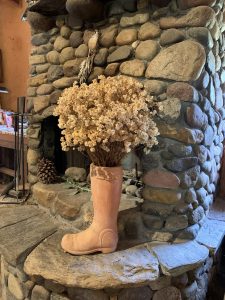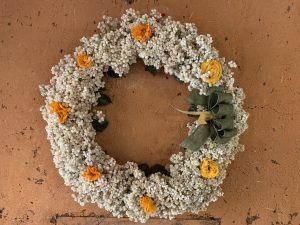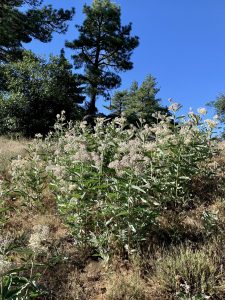Did this train jump off its tracks? We left off in March 2020 with our “This Month in the Natural Garden,” and here we are entering September! I sincerely apologize for the six months of silence on our end, but we all know these have been some of the strangest six months of our lives. Trusting we are all safe and secure in the midst of the Covid-19 pandemic, we can still be certain that our natural gardens provide a source of inspiration and wellness, healing and health, and offer us simple joy through our experiences: viewing, studying, doing a few little chores here and there, watching birds and butterflies, breathing magically aromatic fresh air, managing through whatever crisis hot weather might throw at us, and dreaming about good times ahead.
Current events, history, review, and notes
What happened anyway? We had a few heavy rains at the exact time the lockdown started in March, April brought a few showers, and we ended our official precipitation season in June with a total of 18.5” rain in the guague, slightly above an average year. Our gardens were thriving, though many parks, public gardens and arboreta were closed and we would have to wait for their gates to slowly reopen in summer. For the most part, June and July gave us long days with pleasant warm temperatures and only an occasional touch of real heat. Summer was gonna be fun.
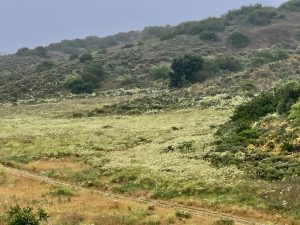
Spring 2020. A season of unprecedented abundance for Pseudognaphalium californicum.
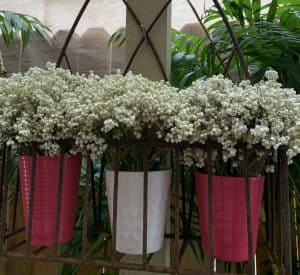 Pseudognaphalium californicum. Common names, ladies tobacco, cudweed, false everlast. The flowers in these vases smell like maple syrup.
Pseudognaphalium californicum. Common names, ladies tobacco, cudweed, false everlast. The flowers in these vases smell like maple syrup.
Everlast wreath by Hilda Evans
But August was not so kind. The first days were relentlessly hot and if you were not ready with valuable moisture socked away in deep cool soils, your plants may have suffered and you definitely had some catching up to do. A couple more really hot spells in August made it hard to perfectly schedule those deep soak events, and I feel bad I was missing in action to coach you along. Well I’m back, and though the days are shorter, the temps can still be extreme, so don’t roll up your hoses just yet!
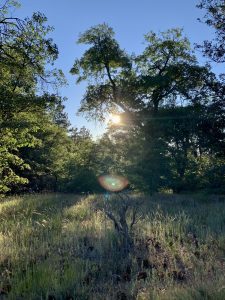 2020 Summer Solstice in San Diego’s Laguna Mountains.
2020 Summer Solstice in San Diego’s Laguna Mountains.
Watering
As many of you know, we water natural gardens in the long dry season, and as necessary in a drier-than-normal winter as follows:
1. “Deep Soak.” Put water in the soil. Apply the equivalent of a 1.5-2” rain event to the entire planted area every 3-4 weeks. Use the “pulse irrigation” technique to apply approx .5” per day, in early mornings, for three consecutive days. For most sprinkler systems you would run the sprinklers approx 40 minutes each day. You won’t need to do this again for around 3 weeks, though the interval could be between 2 and 4 weeks depending on weather, soil, garden maturity, exposure, and many factors. The point is to infrequently but thoroughly soak the soil to a depth of 14-18”. Try to water in anticipation of extreme heat events. Best to water on early mornings on days with cooler summer overcast conditions. This puts moisture where roots will find it when they need it.
2. “Refreshing Sprinkle.” Put water on the plants and soil surface only. Best done by hand (it’s fun) or with the irrigation system, Refreshing Sprinkles take the stress off the plants during hot weather. It’s simple. Go out at the end of the day, in summer, 7:30 pm or so and wet the entire garden with a spray nozzle on your garden hose. Wash the leaves, and wet the soil surface. Spend no more than 5-10 minutes. Turn the hose straight up overhead and take a quick garden shower so you can feel the instant cooling your plants are getting. Watch for hummingbirds who may slip in for a quick bath. You can do Refreshing Sprinkles 2-3 times a week or more, always at the end of the day. This moisture refreshes the leaves and cools the entire site so the garden has a restful “sleep” and can start the next hot day with no stress. Virtually no moisture soaks into the root zone, but the new moisture on the surface helps lock in the valuable moisture from your Deep Soaks.
Be sure to use both of the above practices in unison through the dry season to maintain healthy levels of soil moisture and keep clean, fresh, happy plants.
See watering guide for all the best info on watering.
Related to Watering
The “Deep Soak” you apply in September or October, may be the last of 5 or so for the year. It’s a little early now to be imagining our first rain, but typically we’ll see it in October/November time, not too far off. In the meantime, maintain good soil health by utilizing the Deep Soak, Refreshing Sprinkle Watering Method.
Pruning
If you headed back semi-woody shrubs in late spring, dead-headed soft branched shrubs when their blooms finished, Shaped your salvias and buckwheats, cut the old flowers and branch tips off Ceanothus in June, and generally cleaned up by removing dead branches and artfully shaping your plants all summer long , you are basically ready for fall. No major pruning needed in September.
Weeding
Summer weeds may be setting seed now. If so, before grubbing them out with a hoe, carefully prune off the seed heads and discard them in the trash. This way you will not spread the seeds when you cut the weeds.
Mulching/Top dress
You can scratch up the soil surface or topdress you already have in place, just prior to a Deep Soak irrigation event. Don’t bring any new mulch or top dress onto the site this month.
Feeding
With the early onset of a few cool nights, you might see some new growth on shrubs, typically called “second spring” for many native plants. Though this may be a temptation to feed, it’s still a little early. Wait for the soils to cool slightly. October will be time for an all purpose organic fertilizer.
Troubleshooting – Varmints, Pests and Diseases
The soils are still warm and plants may still be susceptible to summer root rot, especially during an extreme heat event. If plants such as manzanita, coffeeberry, fremontia, Catalina ironwood, even toyon and Pacific wax myrtle go limp and turn brown, and you can rule out lack of water, (because they are in saturated soil), you can know that it was not per se “too much water” that killed them but more accurately “not enough oxygen.” When free moisture takes up all the pore space in warm soils, some native plants will get root rot. This is why deep infrequent Deep Soaks are best. The roots will be growing in a safe soil zone, 8-18” deep where the temps are consistently cool.
Annual Wildflowers
Check your books, websites, photo albums, journals, hiking records and anything that will bring to memory beautiful images of California’s wildflowers. Plan specifically for your garden. But do not put wildflower seed out now unless you want to provide very expensive feed for the birds. The seeds need to sprout in the rain.
Adding New Plants
Given that August was brutal and there’s a heatwave forecast for next week, don’t rush to plant new plants… taking care of them in the first few weeks is a chore. Late September is almost early October and by then we’ll see what kind of patterns are developing on changes in weather and season. Amazingly, the autumnal equinox is only about two weeks away, and Earth’s axis will be swinging towards winter. Hard to imagine.
Asclepias eriocarpa. Indian milkweed, a monarch’s favorite.
Engage
In our “Six Season Calendar” for natural gardens, we consider May and September transitional months, but not just for weather and garden tasks. These two are also great months for reflection and anticipation. In May we kiss spring goodbye and say hi to summer. In September, especially in those first cool evenings and mornings, we should bring to mind the great experiences of summer; long days, short shadows, searing heat in dead silent afternoons, warm sunrises, seed heads on every anxious grass, forb, herb and flower, Scorpius scampering across the southern night sky, and lots of time spent in the bright outdoors. At Tree of Life we celebrate so many cliff swallows and even more little brown bats who feed simarlily in flight, one by day, one by night. The brief times they’re in the sky together at summer’s dusk is pure magic. They’ll be leaving soon.
I breathe the rich warm evening air. There might be a tiny hint of fall in it, but mostly it’s my imagination. But we do get closer every day and when we turn the corner at the end of the month, it will be obvious. Until then, the transition is good. We’re walking a path with one foot striding through the end of summer and the other strutting towards fall, and with a head full of memories and hopes. I actually
like transitions. See you when we get there. Where? Where we’re going. We’re gonna make it!
From the Garden,
Mike Evans
Questions? Help is just one call or one email away. Call (949) 728-0685 or email (with pictures if you like) our special helpline: gardenhelp@californianativeplants.com
To get our monthly updates sign up for our eNewsletter at this link here.
